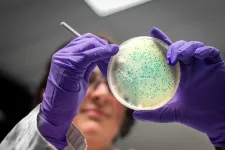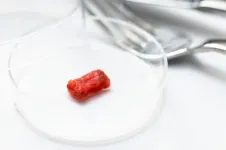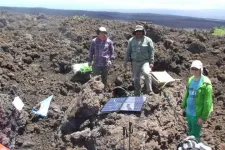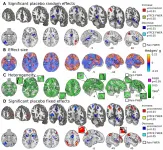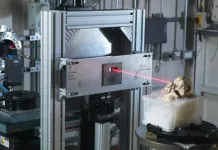(Press-News.org) Northwestern Engineering researchers have developed a theoretical model to design soft materials that demonstrate autonomous oscillating properties that mimic biological functions. The work could advance the design of responsive materials used to deliver therapeutics as well as for robot-like soft materials that operate autonomously.
The design and synthesis of materials with biological functions require a delicate balance between structural form and physiological function. During embryonic development, for instance, flat sheets of embryonic cells morph through a series of folds into intricate three-dimensional structures such as branches, tubes, and furrows. These, in turn, become dynamic, three-dimensional building blocks for organs performing vital functions like heartbeat, nutrient absorption, or information processing by the nervous system.
Such shape-forming processes, however, are controlled by chemical and mechanical signaling events, which are not fully understood on the microscopic level. To bridge this gap, researchers led by Monica Olvera de la Cruz designed computational and experimental systems that mimic these biological interactions. Hydrogels, a class of hydrophilic polymer materials, have emerged as candidates capable of reproducing shape changes upon chemical and mechanical stimulation observed in nature.
The researchers developed a theoretical model for a hydrogel-based shell that underwent autonomous morphological changes when induced by chemical reactions.
"We found that the chemicals modified the local gel microenvironment, allowing swelling and deswelling of materials via chemo-mechanical stresses in an autonomous manner," said de la Cruz, Lawyer Taylor Professor of Materials Science and Engineering at the McCormick School of Engineering. "This generated dynamic morphological change, including periodic oscillations reminiscent of heartbeats found in living systems."
A paper, titled "Chemically Controlled Pattern Formation in Self-oscillating Elastic Shells," was published March 1 in the journal PNAS. Siyu Li and Daniel Matoz-Fernandez, postdoctoral fellows in Olvera de la Cruz's lab, were the paper's co-first authors.
In the study, the researchers designed a chemical-responsive polymeric shell meant to mimic living matter. They applied the water-based mechanical properties of the hydrogel shell to a chemical species, a chemical substance that produces specific patterned behavior -- in this case, wave-like oscillations -- located within the shell. After conducting a series of reduction-oxidation reactions -- a chemical reaction that transfers of electrons between two chemical species -- the shell generated microcompartments capable of expanding or contracting, or inducing buckling-unbuckling behavior when mechanical instability was introduced.
"We coupled the mechanical response of the hydrogel to changes in the concentration of the chemical species within the gel as a feedback loop," Matoz-Fernandez said. "If the level of chemicals goes past a certain threshold, water gets absorbed, swelling the gel. When the gel swells, the chemical species gets diluted, triggering chemical processes that expel the gel's water, therefore contracting the gel."
The researchers' model could be used as the basis to develop other soft materials demonstrating diverse, dynamic morphological changes. This could lead to new drug delivery strategies with materials that enhance the rate of diffusion of compartmentalized chemicals or release cargos at specific rates.
"One could, in principle, design catalytic microcompartments that expand and contract to absorb or release components at a specific frequency. This could lead to more targeted, time-based therapeutics to treat disease," Li said.
The work could also inform the future development of soft materials with robot-like functionality that operate autonomously. These 'soft robotics' have emerged as candidates to support chemical production, tools for environmental technologies, or smart biomaterials for medicine. Yet the materials rely on external stimuli, such as light, to function.
"Our material operates autonomously, so there's no external control involved," Li said. "By 'poking' the shell with a chemical reaction, you trigger the movement."
The researchers plan to build on their findings and further bridge the gap between what's possible in nature and the science lab.
"The long-term goal is to create autonomous hydrogels that can perform complex functions triggered by clues as simple as a local mechanical deformation," Olvera de la Cruz said.
INFORMATION:
Washington, March 2, 2021--A first-of-its-kind analysis of parents' reviews of U.S. public K-12 schools, posted primarily from 2009 to 2019 on the popular school information site GreatSchools.org, found that most reviews were written by parents at schools in affluent neighborhoods and provided information that correlated strongly with test scores, a measure that closely tracks race and family income. Language associated with school effectiveness, which measures how much students improve in their test scores over time and is less correlated with demographics, was ...
Eighty percent of Americans over 50 say their primary care doctor hasn't asked about their hearing in the past two years, and nearly as many - 77% -- haven't had their hearing checked by a professional in that same time, according to a new national poll report.
That's despite a growing body of evidence about the importance of hearing to other aspects of life, from dementia and risk of falls to the ability to stay connected to friends and family.
Men were more likely than women to say they'd had a recent hearing screening or test, and so were people ages 65 to 80 compared with those in ...
COLUMBUS, Ohio - Black players in the NBA have 30% greater odds of leaving the league in any given season than white players who have equivalent performance on the court, a new study finds.
The results were driven mostly by bench players, who are the majority of those in the league, but who average less than 20 minutes of action per game.
These findings suggest that even in the NBA - a league in which Black players make up 70-75% of those on the court - African Americans face discrimination, said Davon Norris, lead author of the study and a doctoral student in sociology at The Ohio State University.
"If there is going to be anywhere in America where you would expect there wouldn't be racial ...
TROY, N.Y. -- Envisioning an animal-free drug supply, scientists have -- for the first time -- reprogrammed a common bacterium to make a designer polysaccharide molecule used in pharmaceuticals and nutraceuticals. Published today in Nature Communications, the researchers modified E. coli to produce chondroitin sulfate, a drug best known as a dietary supplement to treat arthritis that is currently sourced from cow trachea.
Genetically engineered E. coli is used to make a long list of medicinal proteins, but it took years to coax the bacteria into producing even ...
Tokyo, Japan - Humans are largely omnivores, and meat in various forms has always featured in the diet of most cultures. However, with the increasing population and pressure on the environment, traditional methods of meeting this fundamental food requirement are likely to fall short. Now, researchers at the University of Tokyo report innovative biofabrication of bovine muscle tissue in the laboratory that may help meet escalating future demands for dietary meat.
With global urbanization, the economics of animal husbandry are becoming unsustainable. From an environmental viewpoint, the land and water costs of modern mega-scale ...
In a world first, an international team of researchers has read an unopened letter from Renaissance Europe - without breaking its seal or damaging it in any way.
The research, published in Nature Communications, describes how an X-ray scanner used in dental research and 'virtual unfolding' allowed the interdisciplinary team to read the contents of a securely and intricately folded letter which has remained unopened for 300 years, while preserving its valuable physical evidence.
A highly sensitive X-ray microtomography scanner, developed at ...
A volcanic eruption in the Galápagos Islands has given scientists a fresh insight into how volcanoes behave and provided vital information that will help to predict future hazards on the islands.
Irish scientists, based at Dublin Institute for Advanced Studies (DIAS) and Trinity College Dublin respectively, were members of an international research team from Ireland, United Kingdom, United States, France and Ecuador that made the discovery.
The research published today (02.03.21) in Nature Communications reveals the first ever detailed description of a volcanic eruption from Sierra Negra - one ...
Hours before the 2018 eruption of Sierra Negra, the Galápagos Islands' largest volcano, an earthquake rumbled and raised the ground more than 6 feet in an instant. The event, which triggered the eruption, was captured in rare detail by an international team of scientists, who said it offers new insights into one of the world's most active volcanoes.
"The power of this study is that it's one of the first times we've been able to see a full eruptive cycle in this detail at almost any volcano," said Peter La Femina, associate professor of geosciences ...
A large proportion of the benefit that a person gets from taking a real drug or receiving a treatment to alleviate pain is due to an individual's mindset, not to the drug itself. Understanding the neural mechanisms driving this placebo effect has been a longstanding question. A meta-analysis published in Nature Communications finds that placebo treatments to reduce pain, known as placebo analgesia, reduce pain-related activity in multiple areas of the brain.
Previous studies of this kind have relied on small-scale studies, so until now, researchers did not know if the neural mechanisms underlying ...
In June 2019, an international team brought the complete skull of the 3.67-million-year-old Little Foot Australopithecus skeleton, from South Africa to the UK and achieved unprecedented imaging resolution of its bony structures and dentition in an X-ray synchrotron-based investigation at the UK's national synchrotron, Diamond Light Source. The X-ray work is highlighted in a new paper in e-Life, published today (2nd March 2021) focusing on the inner craniodental features of Little Foot. The remarkable completeness and great age of the Little Foot skeleton makes it a crucially important ...

